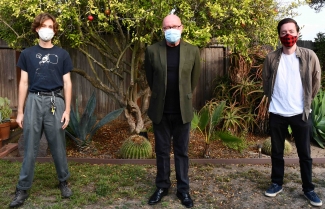The Center for Research in Electronic Art Technology (CREATE) releases EmissionControl2: “The ultimate granulator”

October 14, 2020
The Center for Research in Electronic Art Technology (CREATE) at UC Santa Barbara has released a new software app for sound granulation: EmissionControl2 for MacOSX, Linux, and Windows. EmissionControl2 is a granular sound synthesizer. The theory of granular synthesis is described in the book Microsound (Curtis Roads, 2001, MIT Press). Granular synthesis is one of the most important methods of sound design.
Features of the software include:
- Granulation of multiple sound files simultaneously (up to 1 GB of samples can be loaded)
- Supports up to 2048 simultaneous grains (limited by the user’s hardware)
- Synchronous and asynchronous grain emission
- Intermittency control
- Per-grain signal processing (envelope, waveform, amplitude, frequency, spatial position, filter center frequency, and resonance)
- Modulation control of all granulation parameters with six LFOs (bipolar or unipolar waveforms)
- Real-time display of peak amplitude, grain counter, waveform, scan range, scanner, and grain emission
- Scalable GUI and font size
- MIDI Learn enables mapping to any MIDI continuous controller
- Unlimited user presets with smooth interpolation for gestural design
- Code is open source and available at GitHub
The new app was developed by a team consisting of Professor Curtis Roads acting as project manager, with software developers Jack Kilgore and Rodney DuPlessis. Kilgore is a Computer Science major at UC Santa Barbara. DuPlessis is a PhD student in Music Composition at UC Santa Barbara and is also pursuing an MS degree in Media Arts and Technology.
“Professor Roads and his team worked for 20 months on this outstanding project,” said Professor JoAnn Kuchera-Morin, Director of CREATE. “It is the ultimate granulator,” said Roads, who teaches electronic music at UC Santa Barbara and is also Associate Director of CREATE.
Coded entirely in C++, the app uses the Allolib multimedia software library available on GitHub. “Allolib was created to support the distributed audiovisual system of the UCSB AlloSphere,” according to lead developer Dr. Andrés Cabrera, CREATE Research Director. Cabrera consulted on the Windows version.
EmissionControl2 is a free and open-source software download available here.
The project was supported by a Faculty Research Grant from the UC Santa Barbara Academic Senate.
News release courtesy of the Center for Research in Electronic Art Technology (CREATE).
Read More
Latest News